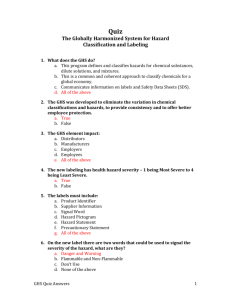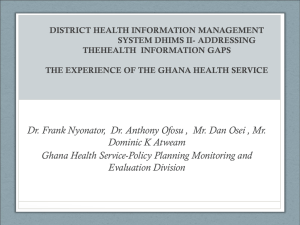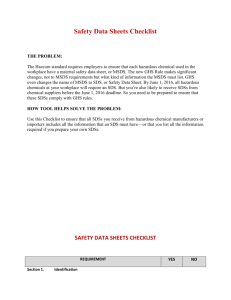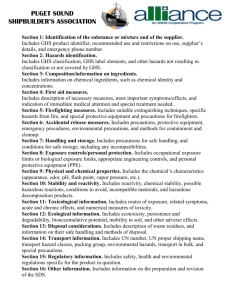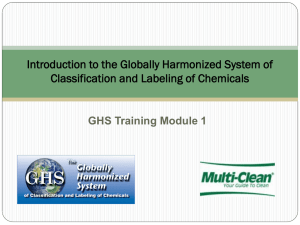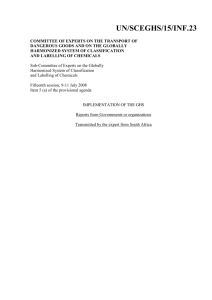un/sceghs/14/inf.24
advertisement
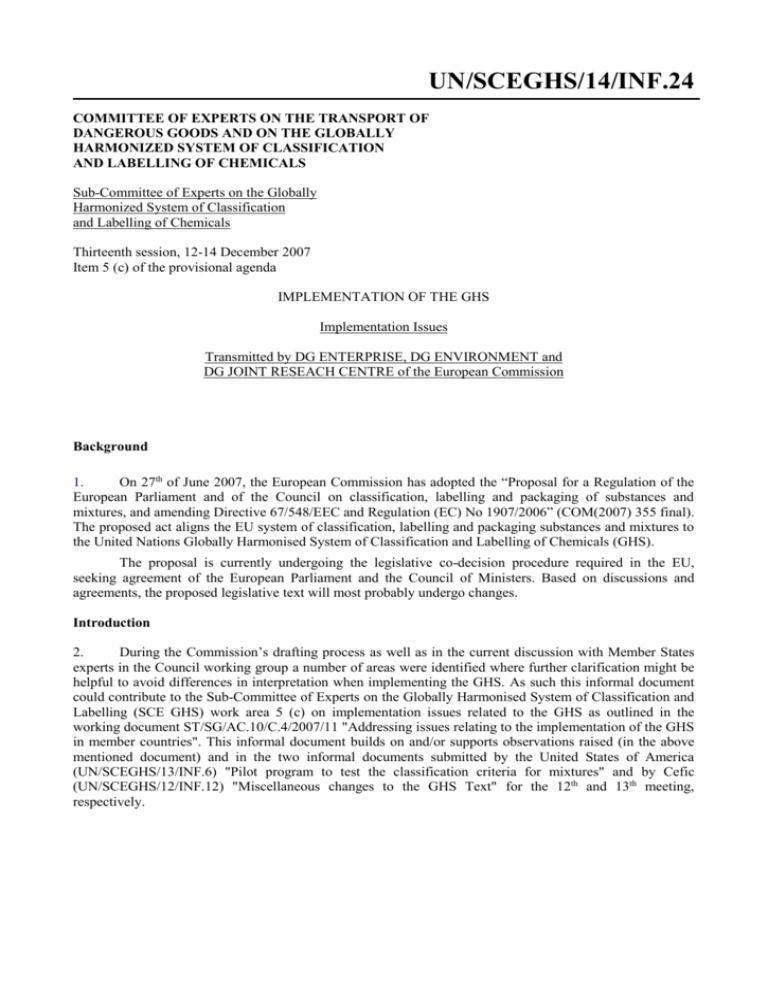
UN/SCEGHS/14/INF.24 COMMITTEE OF EXPERTS ON THE TRANSPORT OF DANGEROUS GOODS AND ON THE GLOBALLY HARMONIZED SYSTEM OF CLASSIFICATION AND LABELLING OF CHEMICALS Sub-Committee of Experts on the Globally Harmonized System of Classification and Labelling of Chemicals Thirteenth session, 12-14 December 2007 Item 5 (c) of the provisional agenda IMPLEMENTATION OF THE GHS Implementation Issues Transmitted by DG ENTERPRISE, DG ENVIRONMENT and DG JOINT RESEACH CENTRE of the European Commission Background 1. On 27th of June 2007, the European Commission has adopted the “Proposal for a Regulation of the European Parliament and of the Council on classification, labelling and packaging of substances and mixtures, and amending Directive 67/548/EEC and Regulation (EC) No 1907/2006” (COM(2007) 355 final). The proposed act aligns the EU system of classification, labelling and packaging substances and mixtures to the United Nations Globally Harmonised System of Classification and Labelling of Chemicals (GHS). The proposal is currently undergoing the legislative co-decision procedure required in the EU, seeking agreement of the European Parliament and the Council of Ministers. Based on discussions and agreements, the proposed legislative text will most probably undergo changes. Introduction 2. During the Commission’s drafting process as well as in the current discussion with Member States experts in the Council working group a number of areas were identified where further clarification might be helpful to avoid differences in interpretation when implementing the GHS. As such this informal document could contribute to the Sub-Committee of Experts on the Globally Harmonised System of Classification and Labelling (SCE GHS) work area 5 (c) on implementation issues related to the GHS as outlined in the working document ST/SG/AC.10/C.4/2007/11 "Addressing issues relating to the implementation of the GHS in member countries". This informal document builds on and/or supports observations raised (in the above mentioned document) and in the two informal documents submitted by the United States of America (UN/SCEGHS/13/INF.6) "Pilot program to test the classification criteria for mixtures" and by Cefic (UN/SCEGHS/12/INF.12) "Miscellaneous changes to the GHS Text" for the 12th and 13th meeting, respectively. UN/SCEGHS/14/INF.24 page 2 Proposal 3. The experts of the Commission services dealing with the GHS would like to bring to the attention of the SCEGHS areas of inconsistency or difficulty that we have experienced. The Sub-Committee could consider these, and if considered appropriate provide further guidance or make adjustments to the text of the GHS at some stage. 4. The following are areas which we have identified where the GHS text could be given greater clarity. This list should be not seen as an exhaustive list, but more as a first compilation of issues. 5. Terminology (a) The GHS uses the term "chemical", however, in some cases the use of the terms "substance(s)" or "mixture(s)" would be more appropriate and would add to clarity. (b) Sometimes terminology is used that is not defined in GHS; for example the term "endpoint" which could be considered to be replaced by "hazard class" or "hazard category" when this is appropriate (e.g. "endpoint" is used in 3.7.2.3.1). (c) At several places the term "structure-property relationship" and "structure-activity relationship" are used, it could be considered to use the more commonly used term "structureactivity relationship". (d) The terms "packaging" and "package(s)" are used as synonyms in the GHS as highlighted in the working document prepared by the secretariat ST/SG/AC.10/C.4/2006/10, although the definitions of both are different by transport and in common dictionaries. Definition used in transport of dangerous goods regulations Packaging: a receptacle and any other components or materials necessary for the receptacle to perform its containment function; Package: the complete product of the packing operation, consisting of the packaging and its contents prepared for transport; 6. Bridging principles (a) As already highlighted in the informal document UN/SCEGHS/13/INF.6 the introductory paragraphs for the application of the bridging principles read "Where the mixture itself has not been tested to determine its [xxx hazardous properties], but there are sufficient data on the individual ingredient and similar tested mixtures to adequately characterize the hazards of the mixture, these data will be used in accordance with the following agreed bridging principles"; this means two conditions are needed. We are questioning, if that was intended. We think that the use of the word "or" (in the meaning of "and/or") would be more logical. Test data on similar tested mixtures should be given equal weight as data on individual substances. (b) There are two paragraphs under the section bridging principles "Interpolation within one toxicity category" and "Substantial similar mixtures". These two bridging principles make use of the descriptors A, B and C in a different way: Whereas in the bridging principle "Interpolation within one toxicity category" A, B and C designate the bridging mixtures, in the bridging principle "Substantially similar mixtures" A, B and C designate ingredients of the bridging mixtures only (which presumably covers both substances and mixtures) while the bridging mixtures are represented by i) and ii). It is confusing to use the same letters A, B and C in a different way and to designate the bridging mixtures one time as A, B and C and some rows later as i) and ii). UN/SCEGHS/14/INF.24 page 3 The use of different letters could provide more clarity. (c) In describing the classification criteria, a consistent order has been followed as well as the same headings. However, this causes confusion for the CMR hazard classes, as the first section is named “Classification of mixtures when data are available for the complete mixture” even though the text specifies that “classification of mixtures will be based on the available test data of the individual ingredients of the mixture using cut-off values/concentration limits for those ingredients.” Although breaking the consistency among the hazard classes, a change of the order for these three hazard classes should be considered, as the approach is indeed different for these three hazard classes compared to the general approach. 7. How to apply different routes of exposure and nature of effects for classification and hazards communication During drafting the EU legislation incorporating the GHS we had to find a solution to distinguish different routes of exposure or type of effects for hazard classes where the applicability was not clear or where the same hazard class includes different types of hazards. The same substance or mixture may have more than one of these hazard properties or should be classified differently for various routes. For these reasons we have seen the need to specify the classification for different hazards and different routes of exposure within the same hazard class. This is the case for: (a) Chapter 3.1: acute toxicity, where a substance shall be classified ("differentiated") in the appropriate category(ies) for all routes of exposure for which the criteria are fulfilled and assigned specific hazard statements for these routes ("fatal/toxic/harmful if swallowed", fatal/toxic/harmful in contact with skin", fatal/toxic/harmful if inhaled)" . For mixtures, however, the text in 3.1.3.2 seems to imply that mixtures need only be classified for one route of exposure which is inconsistent with the provisions for substances and not in line with the hazard statements which just specifies a single route. See also the informal documents UN/SCEGHS/13/INF.6 "Pilot program to test the classification criteria for mixtures" and (UN/SCEGHS/12/INF.12) "Miscellaneous changes to the GHS Text". (b) Chapter 3.4: respiratory or skin sensitisation to clarify that the classification should distinguish the route of exposure that may lead to sensitisation of the airways or the skin, respectively. (c) Chapter 3.7: reproductive toxicity to make it possible to classify for "effects on or via lactation" for a substance or a mixture which is also causing developmental and/or impaired fertility. Developmental toxicity and impaired fertility are not subdivided in the GHS, and substances toxic to reproduction are classified in one category. In the EU proposal, effects on development and fertility are considered separately within each category according to the GHS criteria. For labelling purposes a distinction is made between the two types of effects, in line with GHS. Eight different hazard statements are suggested to be used to specify the type of effect in the labelling of substances and mixtures classified in category 1 or 2. The issue is also brought up in UN/SCEGHS/13/INF.6. (d) Chapter 3.8: specific target organ toxicity, single exposure to clarify that the category 3 hazards, namely respiratory irritation and/or narcotic effects, are both independent and different from specific target organ toxicity (STOT, single exposure), category 1 or 2, see also UN/SCEGHS/13/INF.6. (e) Chapter 4.1 hazardous to the aquatic environment to enable classification of both acute aquatic hazards and chronic aquatic hazards, if the criteria for both type of hazards are fulfilled. . UN/SCEGHS/14/INF.24 page 4 Therefore the EU legislative proposal includes a provision to "differentiate" those above mentioned classes on the basis of the route of exposure or the nature of the effects and which clarifies that the substances or mixture shall be classified in accordance with such differentiation. 8. 9. Acute toxicity, chapter 3.1 (a) In 3.1.3.6.2.1 (a), extrapolation is allowed between oral, dermal and inhalation acute toxicity estimates when data is lacking for an ingredient in a mixture. However, this possibility is not included in the criteria for substances (as brought up at the OECD workshop in Bern, 2007). (b) Paragraph 3.1.3.5.2. seems to allow either the "dilution" (bridging) principle or the ATE formula to be used, which may lead to different classifications (identified at the OECD Workshop in Bern 2007 as an issue needing additional guidance). Skin corrosion/irritation and serious eye damage/eye irritation The chapters on skin corrosion/irritation and serious eye damage/eye irritation including the flow diagrams, Figure 3.2.1 for skin corrosion and irritation potential and the Figure 3.3.1 for serious eye damage and eye irritation, have lead to intensive discussion among experts. One of the main problem seems to be that these chapters are mixing testing and classification strategy, although the GHS focuses on classification and does not promote testing for health hazards. Especially the Figures 3.2.1 and 3.3.1 seem to create problems with regard to clarity despite of the GHS text in 3.2.2.5 & 3.3.2.6 "A tiered approach to the evaluation of initial information should be considered, where applicable (Figure ...), recognising that all elements may not be relevant in certain cases." In the following some of the issues that have been raised are provided: (a) In both figures, are the steps 1a-c needed; the hierarchy of data use (e.g. human data have precedence over animal data, if no data are available SAR may be applied) for classification is a general strategy and does not need to be specifically mentioned here. (b) The step 2a might not be needed; the possibility to use SAR is already mentioned in the criteria text in 3.2.2.1. (c) The correctness of the flow chart for eye irritation may be questioned in step 1c, as classification for eye irritation based on human evidence of skin irritation may not generally be advised automatically. Is there a valid correlation between these effects? (d) Fig 3.2.1 indicates that even if a validated in vitro test for skin corrosion (in step 5) gives a negative result, then an in vivo skin corrosion test is required in step 7. This may be an unnecessary use of animals. The need for confirmatory in vivo testing should depend on whether a particular in vitro test can reliably identify non skin corrosives/irritants or not. Where an in vitro test can reliably identify both corrosives/irritants and non corrosives/non irritants confirmatory testing might not be necessary. (e) It is not clear in which subcategory a corrosive substance should be classified if based on human data, extreme pH, in vitro or SAR results. We recommend that experts should revisit these chapters and especially reconsider the Figures and the text related to them to avoid inconsistencies. Some experts have raised the issue about the lack of reasonable balance between chemicals classified as corrosive and as irritant. UN/SCEGHS/14/INF.24 page 5 10. Use of terminology relating to cut-off values and concentration limits We know that in the GHS "cut-off values/concentration limits" are used as synonyms. In the GHS there are parameters for two different thresholds that trigger differing requirements; (a) The threshold at which substances are taken into account when considering classification (see e.g. 3.1.3.3 (a), 3.2.3.3.1, 3.3.3.3.1 and 4.1.3.1). This also triggers other requirements such as the requirement for a Safety Data Sheet; (b) The threshold at which a substance directly triggers classification (and labelling), e.g. as an impurity in a substance or a substance in a mixture The GHS uses the term “cut-off value/concentration limit” to cover both these limits. To avoid confusion we have used the terms in the following way in the EU proposal: (i) “Cut-off Value” for the thresholds at which substances are taken into account (e.g. in the additivity formulas) when considering classification et alia (ii) “Concentration Limit” to apply to the threshold at which a substance triggers classification (and labelling). Concentration Limits can be either “Generic Concentration Limits” (Default Concentration Limits as specified in the individual hazard class chapters in Parts 2, 3 and 4 of the GHS) or “Specific Concentration Limits” as determined in line with the provisions in 1.3.3.2 of the GHS. Conclusions 10. As the role of the UN SCEGHS has moved from setting the provisions of the GHS system to that of maintaining the system we want to make the Sub-Committee aware of issues which are difficult to interpret and are leading to problems for implementation. Additional guidance and/or clarification of the language of the GHS text would be beneficial for countries in the implementation stage. Countries in the implementation stage have to have solutions to avoid differences in the interpretation by the final user. 11. We will continue to collect and inform the Sub-Committee about issues related to clarification of the classification criteria that we might become aware of while preparing guidance documents on the proposed Regulation of the EU Commission based on the GHS. 12. As a short term solution the EU intends to tackle most issues for further clarity in additional guidance documents which can be easier changed and amended than a legal act to avoid inconsistencies in the application of the GHS system in the long-term. ---------------

